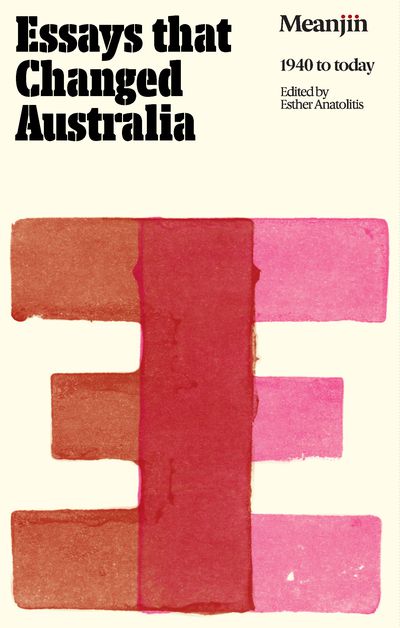
- Free Article: No
- Contents Category: Essay Collection
- Review Article: Yes
- Article Title: Eight decades on
- Article Subtitle: Clem Christesen’s ‘well established’ quarterly
- Online Only: No
- Custom Highlight Text:
John Tregenza’s 1963 study of Australian Little Magazines noted that neither Meanjin nor its near-contemporary Southerly could be characterised as ‘little’, unlike their predecessors and earlier selves. No longer solely dependent on subscription income from a small local band of devotees, both had attracted a wide following. Indeed on transferring his journal from Brisbane to the University of Melbourne in 1945, Meanjin’s Clem Christesen claimed that it had become ‘a well-established quarterly ... with a circulation of 4,000 copies per issue’.
- Featured Image (400px * 250px):

- Alt Tag (Featured Image): Wilfrid Prest reviews ‘Essays That Changed Australia: Meanjin 1940 to today’ edited by Esther Anatolitis
- Book 1 Title: Essays That Changed Australia
- Book 1 Subtitle: Meanjin 1940 to today
- Book 1 Biblio: Melbourne University Press, $34.99 pb, 268 pp
- Book 1 Cover Small (400 x 600):

- Book 1 Cover (800 x 1200):

- Book 1 Readings Link: https://www.readings.com.au/product/9780522880977/essays-that-changed-australia--esther-anatolitis--2024--9780522880977#rac:jokjjzr6ly9m
In keeping with the Christesen tradition, the editorial introduction to this ambitiously titled anthology maintains that over the past eight decades ‘no literary project has matched Meanjin’s impact on Australian culture’. Some Sydneysiders might contest that claim on Southerly’s behalf. At all events, the biographies of essayists featured in the current collection and the helpful list of past editors appended to the back gatefold suggest that Meanjin is at least as much a Melbourne icon as an all-Australian institution.
Esther Anatolitis has picked twenty pieces from issues published between 1942 (Vance Palmer’s call to arms in ‘Battle’) and 2023, when she herself became editor (Jane Howard on the state of arts criticism and Gaja Kerry Carlton on the Brisbane-centered Wulara-Nguru historical language mapping project). Indeed, no fewer than six of her chosen texts date from the current decade. The other four are Michael Mohammed Ahmed’s ‘It’s shit to be White’, Naheed Elrayes’s ‘Gaza and the twenty-year War on Terror’, Amy McQuire ‘The act of disappearing: On the silences that shroud the disappearances of Aboriginal women and girls’ and Chelsea Watego’s ‘Always bet on Black (power)’. Taken together with Marcia Langton’s 2011 ‘Reading the constitution out loud’ and the 2016 contribution by Jenny Hocking and Nell Reidy arguing for an ‘inescapable link between marngrook and Australian [rules] football’, nearly half the works included were first published within the past fifteen years.
Of the dozen original twentieth-century essays, six first appeared between 1940 and 1979, with a further six from the 1980s and 1990s (the 2000s is a blank decade so far as this anthology is concerned). Since only one of the current century’s contributions runs to fewer than ten pages, the more numerous and generally shorter twentieth-century works occupy slightly less of the book’s total extent. A more balanced chronological distribution would surely have produced an overwhelming preponderance of male authors, rather than an actual bare majority of female essayists, and certainly fewer Indigenous authors, since Aboriginal and Torres Strait Islander writers did not appear in Meanjin before 1977.
As for changing Australia, it seems a bit premature to claim much recent writing, however important and interesting, has been a catalyst, let alone a cause of, Australian change, cultural or otherwise. It would be more plausible to present all these essays as reflecting significant currents of thought and feeling, past and present, which is essentially the fallback position enunciated towards the end of Anatolitis’s introduction. Whether Meanjin’s essays do or did adequately ‘map the multiple trajectories that make up our culture ... and clash in our politics’ is another question altogether. To take but one example, republishing an eloquent and moving 2021 denunciation of Israeli actions in Gaza with editorial reference to ‘the atrocities the world is witnessing in Gaza today’ but no mention of the 7 October 2023 Hamas attack seems insensitive at best, at worst anti-Semitic.
One might also ask how far or fundamentally has Australia changed over the past eighty years? We have exchanged formal dominion status in the British empire for cultural and military dependence on the United States. This country remains a geographically isolated, demographically and diplomatically insignificant offshoot of European settlement, a federated constitutional monarchy in the Westminster tradition, heavily reliant on primary industry and struggling to come to terms with the descendants of the continent’s original inhabitants. Among other things, the result of the Voice referendum and the current state of Australian universities hardly suggest the demise of ‘colonialist’ racial prejudice and utilitarian anti-intellectualism. Plus ça change ...
Yet marketing hype and editorial idiosyncracies notwithstanding, this collection contains a wealth of outstanding material, not least what is now evidently and perhaps unsurprisingly the most cited of all Meanjin essays, A.A. Phillips on ‘The Cultural Cringe’ (1950). Other brief pieces which I much enjoyed, for various reasons, are Thea Astley’s 1968 musings on ‘The temperament of generations: The Monstrous accent on youth’, Manning Clark’s jeremiad ‘Are we a nation of bastards?’ composed in the immediate aftermath of the 1975 dismissal, and Gerald Murnane’s 1986 ‘Why I write what I write’.
Among the longer pieces still well worth reading are: Tim Rowse’s ‘Heaven and a Hills Hoist: Australian critics on suburbia’ (1978, with Rowse’s updated ‘more positive’ assessment of the public policy work of Hugh Stretton); David Yencken’s 1988 ‘Creative City’; Tony Birch’s hard-hitting 1989 account of the ‘making and unmaking of Koori culture’, with particular reference to the naming and renaming of Victoria’s Western District (most notably ‘The Grampians’ by Mitchell’s survey party in 1836, renamed, more recently, ‘Gariwerd’ by the state Place Names Committee); and, finally, Hilary Charlesworth’s meticulous 1992 dissection of feminist perspectives on equality and the law.


Comments powered by CComment